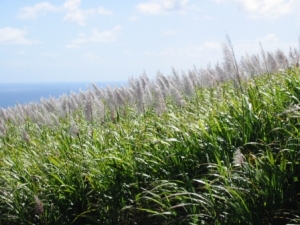The Sugarcane Genome Sequencing Initiative (SUGESI): Strategies for Sequencing a Highly Complex Genome

Sugarcane cultivars derive from recent interspecific hybrids obtained by crossing Saccharum officinarum and Saccharum spontaneum and represent relevant feedstock used worldwide for biofuel production. The challenge in a sugarcane sequencing project is the size (10 Gb) and complexity of its genome structure that is highly polyploid and aneuploid with a complete set of homo(eo)logous genes predicted to range from 8 to 10 copies (alleles). Although sugarcane’s monoploid genome is about 1 Gb, its highly polymorphic nature represent another significant challenge for obtaining a genuine assembled monoploid genome. A sugarcane R570 BAC library whose construction was funded by ICSB is available for sequencing. The genome coverage of this library is believed to be around 1,3x suggesting that recovery of all alleles would not be always efficient. In any case, BAC screening can be undertaken using a fast and efficient 3D-pool approach which has been developed at CNRGV followed by PCR amplification of genes of interest.
The Sugarcane Genome Sequencing Initiative – A particularly attractive initial strategy that lies at the intersection of the common interests of virtually all of the sugarcane research community is to capture much of the gene-rich recombinationally-active euchromatin. The Sugarcane Genome Sequencing Initiative (SUGESI) was envisaged to join efforts to produce a reference sequence of a sugarcane cultivar ( Saccharum hybrid) and ancestor genotypes ( Saccharum officinarum and Saccharum spontaneum) using a combination of approaches but mainly focused on BAC sequencing. The SUGESI Consortium aggregates researchers from Australia, Brazil, France, South Africa and United States. The SUGESI Initiative intends to make sequences public as soon as minimum assemblies permit.
Publications related to the project :
- A mosaic monoploid reference sequence for the highly complex genome of sugarcane
- Building the sugarcane genome for biotechnology and identifying evolutionary trends
- The Sugarcane Genome Challenge: Strategies for Sequencing a Highly Complex Genome
List of partners:
Dr Marie-Anne Van Sluys, Professor of Botany GaTE Lab (Genomics and Transposable elements)
Departamento de Botânica-IBUSP
rua do Matao, 277 05508-900;
São Paulo, SP, BRASIL
Dr Glaucia Souza
Associate Professor
BIOEN Program Coordinator Instituto de Química
Universidade de São Paulo
Dr Angélique D'Hont
CIRAD, UMR 1098 DAP Equipe "Structure et évolution des génomes" TAA96/03,
Avenue Agropolis
34398 Montpellier cedex 5, FRANCE
Dr Andrew Paterson
Plant Genome Mapping Laboratory Center for Applied Genetic Technologies
111 Riverbend Road, Athens, GA 30606
Dr Ray Ming
University of Illinois at Urbana-Champaign
1201 W. Gregory Drive 148 ERML, MC-051
Dr Robert Henry
Southern Cross University
Centre for Plant Conservation Genetics Bioenergy Research Institute/Lismore, NSW Australia
Dr Rosanne Casu
Queensland Bioscience Precinct -
St Lucia 306 Carmody Road
St Lucia QLD 4067 Australia
Dr Bernard Potier
South African Sugarcane Research Institute
Private Bag X02 Mount Edgecombe
4300 South Africa
CNRGV's responsible
- Sonia Vautrin
